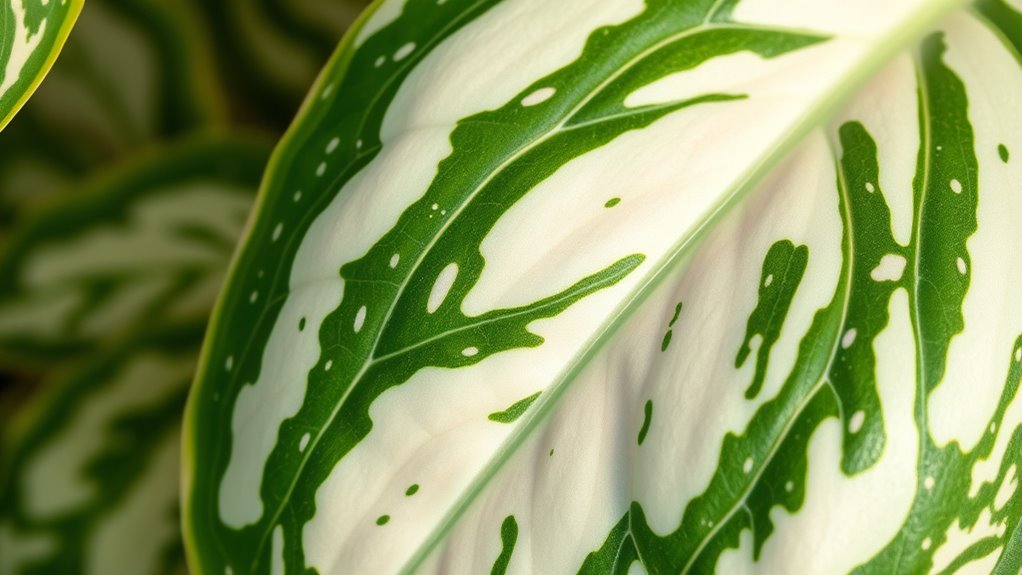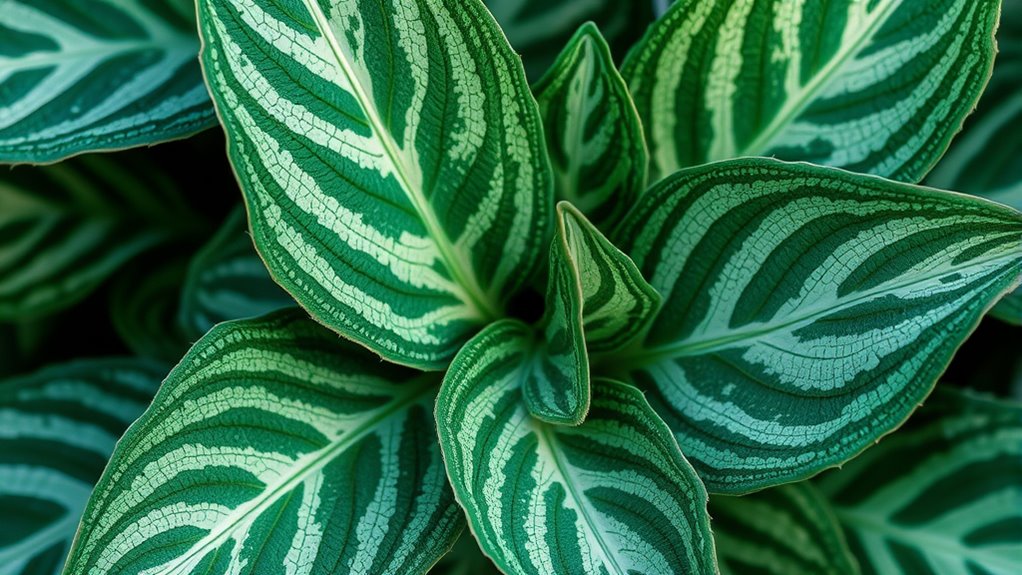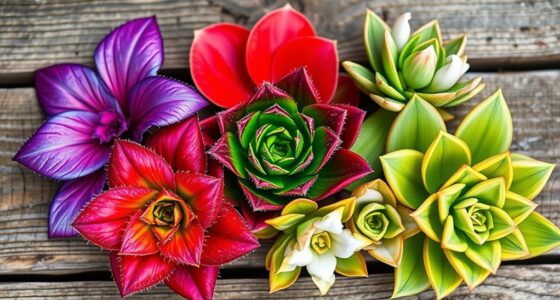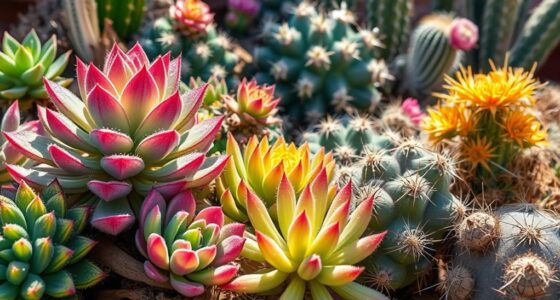Variegation in plants happens because of genetic mutations that disrupt how chlorophyll is produced or distributed within the leaves or flowers. These mutations cause uneven patches or streaks of different colors, creating striking patterns that catch the eye. Some variegated traits are inherited and stable, while others are temporary or environmental. Understanding these cellular and genetic changes helps reveal why rare variegated plants look so unique. Keep exploring—there’s a lot more fascinating science behind these colorful patterns.
Key Takeaways
- Variegation results from genetic mutations that alter chlorophyll production, creating patches of contrasting color on plant tissues.
- Uneven chlorophyll distribution, controlled by genetic factors, causes mosaic-like patterns and enhances visual interest.
- Some variegation is heritable and stable across generations, while others are temporary or environmentally influenced.
- Cellular processes regulate pigment synthesis and transport, leading to diverse and unpredictable variegation patterns.
- Understanding the genetic and cellular mechanisms behind variegation helps in breeding and appreciating rare, ornamental plants.

Have you ever noticed the striking patterns of different colors on plant leaves or flowers? These eye-catching displays are often due to variegation, a phenomenon that results in patches or streaks of different colors on otherwise uniform foliage. At the core of this fascinating patterning lies the intricate interplay of genetic mutations and how chlorophyll is distributed within the plant tissues. Understanding this process can deepen your appreciation for the beauty of variegated plants and reveal the captivating science behind their unique appearances. Genetic mutations are fundamental to variegation. They occur when there are changes in a plant’s DNA that affect how certain genes operate. In many cases, these mutations impact the genes responsible for chlorophyll production or distribution. Chlorophyll, the pigment that gives plants their green color, is essential for photosynthesis, but when its production is altered or unevenly spread, it creates contrasting patches of color. For example, some mutations might suppress chlorophyll in specific cells, leading to white or pale areas, while other parts remain rich in green. This uneven chlorophyll distribution results in the distinctive variegated patterns we see on leaves and flowers. The distribution of chlorophyll is not random; it’s carefully controlled by genetic factors. In variegated plants, mutations can cause cells to either overproduce or underproduce chlorophyll, or even prevent its formation altogether in certain regions. This results in the mosaic appearance of green and non-green areas. Sometimes, this pattern is stable and inherited through generations, especially in cultivated varieties, making variegation a desirable trait in ornamental gardening. Other times, it may be a temporary feature caused by environmental factors or somatic mutations that occur during the plant’s development. Interestingly, the stability of these mutations influences how persistent the variegation is. Some mutations are heritable and consistent, leading to plants that reliably display their variegated patterns. In contrast, other mutations may only occur sporadically or be reversible, causing the variegation to fade or change over time. The way chlorophyll is distributed in these plants is also affected by cellular mechanisms that control pigment synthesis and transport. Differences in these processes can lead to the beautiful, unpredictable patterns that make variegated plants so mesmerizing. Moreover, understanding genetic mutations can help horticulturists develop new variegated cultivars with desirable traits. In essence, variegation is a stunning example of how genetic mutations influence chlorophyll distribution, creating the vibrant and diverse patterns that catch your eye. It’s a perfect fusion of genetics and cellular biology, reminding you that nature’s artistry often has a scientific explanation. By understanding these underlying mechanisms, you gain a new perspective on the rare and beautiful variegated plants that brighten your garden or home.
Frequently Asked Questions
Can Variegation Be Genetically Predicted?
You might wonder if variegation can be genetically predicted. While genetic markers and inheritance patterns play a role, predicting variegation isn’t straightforward due to its complex genetic basis. Some plants show clear inheritance, but environmental factors and mutations also influence variegation. So, although genetic testing offers clues, it doesn’t guarantee the appearance of variegation in future plants. Keep in mind, nature often adds surprises beyond genetic predictions.
How Do Environmental Factors Influence Variegation Patterns?
Environmental factors like light exposure and soil composition notably influence variegation patterns. When you provide ideal light, it can enhance the contrast between green and variegated areas, making patterns more vivid. Similarly, soil composition affects plant health, which in turn impacts variegation. Poor soil might cause uneven growth, dulling the pattern, while well-balanced soil supports consistent variegation development. You can shape variegation by adjusting these environmental conditions.
Are All Variegated Plants Equally Stable Over Time?
You might think all variegated plants are equally stable, but surprise—genetic stability varies widely. While some hold their striking patterns over time, others are more sensitive to environmental influences, causing their variegation to fade or change. So, don’t assume your plant’s vibrant look will last forever; its stability depends on its genetics and the environment it’s in. Keep a close eye, and you’ll better understand its unique tendencies.
What Are the Best Practices for Propagating Variegated Plants?
When propagating variegated plants, you should focus on cutting propagation for best results. Use healthy, disease-free stems and employ proper rooting techniques like providing consistent moisture and suitable humidity. Keep cuttings in bright, indirect light and avoid overwatering. Patience is key; roots typically develop within a few weeks. This method helps maintain the variegation pattern and ensures healthy new plants, giving you a successful propagation process.
How Does Variegation Affect a Plant’S Overall Health?
Variegation can impact a plant’s overall health by reducing photosynthesis efficiency, since the lighter-colored areas have less chlorophyll. This means you might notice slower growth or weaker nutrient absorption. To support your variegated plants, make sure they get adequate light, but avoid direct sun, and provide balanced fertilization. By doing so, you help compensate for their reduced photosynthesis, promoting healthier growth despite their unique leaf patterns.
Conclusion
Think of variegation as a hidden treasure map etched into each leaf, revealing a secret world of color and mystery. Just as explorers marvel at discovering uncharted lands, you can appreciate the rare beauty that these plants hold. Embrace the journey of understanding their science, and you’ll see each variegated leaf as a vibrant chapter in nature’s grand story—one that invites you to marvel at its artistry and wonder.










